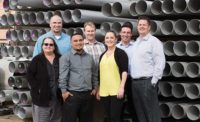Imagine the biggest ASHRAE Show you've ever attended and then multiply it by 10. Imagine the McCormick Place exhibition halls in Chicago or the Jacob Javits Center in New York and triple them.
That's how big the biennial International Sanitar Heizung Clima is, a show so big that you take shuttle buses between halls filled with heating and plumbing products from around the world. It's a show so big that the more than 200,000 attendees drive hours every day from hotels all over northwest Germany to get to the show.
Show organizers aren't blowing smoke when they estimate attendance at 220,000. On the first day our busload of American contractors, wholesalers and manufacturers reps got to the show, it seemed like there were 200,000 people just in Hall 8, the boiler and radiator hall. It was packed shoulder to shoulder.
Booths of major boiler manufacturers such as Viessmann and Buderus are more like small villages. Some of the smaller booths are bigger than the big booths at ASHRAE.
In an extremely civilized practice that we'll never see in the United States, many major exhibitors offer customers and important visitors free beer or Coke and a bite to eat, usually sausage.
While major U.S. HVACR manufacturers complain that ASHRAE costs them about $500,000, Christopher J. Hoff, Buderus' vice president/marketing and administration, estimates that Buderus as well as Viessmann spend $4 million each at ISH.
And with good reason. Viessmann reportedly writes 40% of its business for the next two years at ISH. With those kinds of sales on the line, European manufacturers are under tremendous pressure to produce something worth-while for the show. Even now, R&D departments are working feverishly on what products will be shown in 2001.
Boilers, boilers everywhere
All of the boilers, even from no-name regional manufacturers, are sleek, colorful and topped with an array of electronic controls.Viessmann introduced a line of wall-hung condensing boilers it's bringing to North America. Several contractors in our group believe that wall-hung boilers may be an idea whose time has come in the United States, especially in multifamily housing and for small houses built on slabs.
The boilers also produce instant domestic hot water through a plate-type heat exchanger.
The units use Viessmann's Matrix radiant gas burner. The burner looks like a stainless-steel mesh colander. There's no open flame. The steel mesh surface glows. The Matrix burner reportedly produces so little CO and NOx that you can breathe the exhaust emissions without harm.
The boilers are rated at a DIN standard efficiency of 108%. (The DIN standard gives extra credit for condensing technology.)
The company also introduced its Vitola 200, an updated version of the Vitola Biferral oil boiler. The boiler still features the biferral cast- iron-and-steel heat exchanger and produces DIN standard efficiencies up to 94%.
Viessmann, which started painting its boilers orange years ago, grew tired of seeing copycat orange boilers and switched to silver with orange accents.
It became clear from walking around the boiler and radiator hall that the Europeans are firmly convinced that the best way to generate heat incorporates hydronic heat with a domestic hot-water coil in a separate tank. Viessmann offers such systems but it also offers Vitocell hot-water tanks that fit underneath its boilers. There's no worry that the boiler will have to be removed to replace the hot water tank. The tank is guaranteed for life.
Buderus introduced a large commercial boiler designed to work with extremely low return-water temperatures. Return water comes in at the top of the boiler and moves through what Buderus is calling a Hydrodiverter to an outer heat exchanger, where it's tempered, then through the inner heat exchanger next to the combustion chamber.
Buderus also showed its easy-to-balance panel radiators. The dial-in flow setter can be adjusted to balance water flow. The thermostatic control head pops on over the flow setter.
Most major European boiler manufacturers also showed lines of vacuum-tube solar collectors, which make sense if you're only trying to produce 140°F water.
Among them was Stiebel Eltron, which was showing a line of wall-hung boilers under the HydroTherm name. It's the same name and logo as the Mestek trade name, except Stiebel Eltron owns the European rights. The hydronic-solar combination uses a large dual coil storage tank with the solar hot-water coil on the bottom of the tank and the boiler coil on the top. The boiler is actually controlled as the secondary heating source. Supply water comes off the top of the tank to a manifold where it's distributed for heating and domestic hot water.
PEX and panels
Stadler Corp. showed its Climate Panel retrofit floor system. The system is a nod to American wood-frame construction and is designed to make it easier to retrofit radiant floor heat without building up existing floors to an unacceptable height. The system is made out of laminated wood panels only ½-in. thick, 7 in. to 10 in. wide and 48 in. long. PEX tubing snaps into slots in the panels, which can be applied either above or below the subfloor.Rehau showed a back-saving PEX tubing clip installer. Rigid board insulation goes down first followed by the PEX tubing. The long-handled installation tool contains a roll of plastic fasteners on a belt, allowing the installer to remain standing and punch the fasteners over the tube into the insulation board. Vasco was showing its colorful line of tubular radiators.
"We want to design radiators that are decorative for any room in the house," says Andrew Pate, the firm's U.K. sales manager. The 20 different styles come with mirrors, shelves, towel rings and robe hooks, which allow the radiators to double as furniture. The design-driven products are purposely made to be the centerpiece of a room, Pate explains, to make buying a radiator a "heart vs. head" buying decision.
Shock the inspectors
One of the U.S. contractors on the trip believes that someone should take a busload of code inspectors to ISH, because many of the products are not yet approved for the United States.One product that caught the contractors' eye is a solderless copper tube joining system. The special fittings contain O-rings. The copper tube is deburred so it doesn't tear up the O-ring and then inserted fully into the fitting. An electric hand tool, either corded or cordless, clamps around the fitting and crimps it around both sides of the O-ring in four seconds. Crimping jaws are available for tube sizes up to 6 in.
One version of the joining system is undergoing U.S. code approvals and may arrive on the market this year.
Also not allowed in the United States are Weishaupt gas, oil and dual fuel burners, which the contractors in our group say are the best burners in the world. The burners are two-stage, three-stage or modulating.
Code inspectors would have done a double-take at the booth of the Dutch company Polva Pipelife B.V., which was showing a plastic chimney liner. A company representative acknowledges that, while earlier versions of plastic chimney liner failed the firm's corrugated, flexible polypropylene liner is approved in Europe up to 248°F, and its rigid pvc liner is approved to 320°F.


